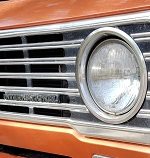|
I need advice and instructions for repairing this! I have a 2013 ford focus, the trunk light comes on- it says the trunk is open. And the key or release button don't work. I searched and found that the common issue is a short. Bad design: the wires get chewed up in the door mechanism. So I found it, and I have very little experience with this but it should be easy, right? There's not a lot extra wire, like slack. Is this something doable? What do I need? I mean it can't possibly get worse, so I should try. (I hope this is the right place to post this)  
|
|
|
|
|

|
| # ? Jun 9, 2024 23:24 |
|
I was thinking about points ignition systems (aka Kettering) and considered that there's a real chance that the engine could stop with the points in the closed position. Then if you were to turn the ignition switch in "run" (but not crank it) battery voltage would be flowing through your coil's primary continuously. This seems like a real fast way to overheat and destroy a coil, doesn't it? And yet, I've never heard about this happening. I must be missing something.
Hunter2 Thompson fucked around with this message at 00:35 on Jun 14, 2020 |
|
|
|
Peeches posted:I need advice and instructions for repairing this! That is very repairable and you've got plenty of slack to work with there. If the factory routing is a problem then you'll probably want to extend the wiring anyway to give it some extra flexibility. You'll need a wire stripper, a crimper, some butt connectors of the appropriate wire gauge, some extra wire to extend that with, and probably some fabric wire tape to provide better chafing protection. Hunter2 Thompson posted:I was thinking about points ignition systems (aka Kettering) and considered that there's a real chance that the engine could stop with the points in the closed position. Then if you were to turn the ignition switch in "run" (but not crank it) battery voltage would be flowing through your coil's primary continuously. This seems like a real fast way to overheat and destroy a coil, doesn't it? And yet, I've never heard about this happening. I must be missing something. I've never heard of this directly happening to anyone, but I've seen people mention it on rare occasion. To be fair, points ignitions basically disappeared in the mid 1970s. I would not be the least bit surprised if a very significant portion of pre-points cars have already been converted, especially the ones that get driven.
|
|
|
|
Peeches posted:I need advice and instructions for repairing this! You'll need some extra wire, some wire crimp connectors, and a crimper (preferrably one with a wire stripper as well). I would solder it and shrink wrap it, but I have a soldering gun and experience doing that sort of stuff. But you can get a bit of wire, a crimper and some crimp connectors at Harbor Freight really cheap and fix that easy. Just do one wire at a time and make sure you don't mix them up and you'll be fine. e: beaten!
|
|
|
GOD IS BED posted:You'll need some extra wire, some wire crimp connectors, and a crimper (preferrably one with a wire stripper as well). I would solder it and shrink wrap it, but I have a soldering gun and experience doing that sort of stuff. But you can get a bit of wire, a crimper and some crimp connectors at Harbor Freight really cheap and fix that easy. Just do one wire at a time and make sure you don't mix them up and you'll be fine.
|
|
|
|
|
Hunter2 Thompson posted:I was thinking about points ignition systems (aka Kettering) and considered that there's a real chance that the engine could stop with the points in the closed position. Then if you were to turn the ignition switch in "run" (but not crank it) battery voltage would be flowing through your coil's primary continuously. This seems like a real fast way to overheat and destroy a coil, doesn't it? And yet, I've never heard about this happening. I must be missing something. I'm going to post what I think, hopefully this will bait an actual electrical engineer to correct me and we can learn something. Edit. Whoa even I know that's wrong. I am just guessing that once the magnetic field is charged it doesn't use much current? Resistance increases drastically? StormDrain fucked around with this message at 01:01 on Jun 14, 2020 |
|
|
|
Peeches posted:I need advice and instructions for repairing this! If you can't find a replacement trunk wiring harness easily/cheaply, then you could repair your harness by splicing in a short section of new wires. It's not too difficult but you'll need tools and parts to do it correctly. To repair it well you'll need: * wire strippers * crimping tool * heat gun (you could substitute a lighter) * appropriate size heat shrink * appropriate size splices (I recommend using parallel splices, rather than butt splices.) * appropriate size wire (probably 16 or 18 AWG, GXL type) * wire harness wrap to reinforce the wiring so it doesn't happen again The repair is simple, cut out the bad wire, splice in a new piece of wire. Some tips: * use ratcheting crimpers that don't unlock until the crimp is finished * unclip the harness so it's easier to work with * stagger your splices across the different wires so they're not all in the same place * don't use PVC "electrical tape" instead of harness wrap, it'll become a gooey mess * put the heatshrink on the wire before you crimp it 
|
|
|
|
Peeches posted:Are wire connectors the same color as the wires? How do I know which ones to buy? No, they're color-coded by size. The ones most commonly found for car use are red (smallest), blue (med), and yellow (largest). Wires too small for red / too big for yellow usually need un-insulated crimps. At a glance I'd bet those wires would fit into red or blue. Of course I'm the type to go overkill on buying supplies so that I'm rarely out of something when I need it, but I've been quite happy with this kit of butt splices: https://www.amazon.com/gp/product/B07Q3JJRY8/ref=ppx_yo_dt_b_search_asin_title?ie=UTF8&psc=1 Also, before you heat shrink anything, tug on the wires *hard* after you do both crimps. A good crimp should hold up to a really hard pull.
|
|
|
|
Peeches posted:Are wire connectors the same color as the wires? How do I know which ones to buy? They probably won't be the same color- what's important is the size of the wire and it's fit inside the connector. You want it to go into the connector snugly, and stay put when you crimp it down. I'd recommend getting an assortment of connectors to make sure you get a good fit. My order of operations on this job would be this: 1. Pick a wire and snip off the damaged area. 2. Strip off the ends of the wires, exposing the bare cable. Look out for dark colored metal, that's a sign of corrosion. Yours look ok from the pic though. 3. Cut a length of new wire and figure how much I'd need. You probably want some more slack, but not so much that it hangs low and snags on things. Strip both ends. 4. Twist the existing wire to keep the strands together when you insert it into the connector. 5. Insert the existing wire into the connector. It should fit in smoothly, with very few (if any) strands sticking out. 6. Crimp the connector down. Give a small tug to make sure it will stay in place. 7. Insert the new wire into the connector and crimp it down. Again, give a slight (or hard as the poster above mentioned) tug to make sure the connection is solid. If there is a concern of wires shorting, or getting wet, at this point, you'd put on some shrink wrap and shrink wrap over the entire connection. I don't think you'll have that problem in your trunk, and most butt connectors have plastic insulation over them already, so shorting shouldn't be an issue. 8. Repeat steps 4-7 for the other side of the wire. 9. Repeat steps 1-8 for all broken wires. 10. Test operation to make sure the wires won't get mangled or yanked out again. Hope this helps! e: Hunter2's tips are really good
|
|
|
IOwnCalculus posted:No, they're color-coded by size. The ones most commonly found for car use are red (smallest), blue (med), and yellow (largest). Wires too small for red / too big for yellow usually need un-insulated crimps. Thanks! Last question, do I need to unplug the battery first? And if so, how is that done , I've never done it before 
|
|
|
|
IOwnCalculus posted:No, they're color-coded by size. The ones most commonly found for car use are red (smallest), blue (med), and yellow (largest). Wires too small for red / too big for yellow usually need un-insulated crimps. Oh thank you, there's gooey tape on there now, I wonder if someone tried to fix it, I just bought it
|
|
|
|
|
Unplugging the battery isn't a bad idea, although I'd probably do the job without taking that precaution (because I didn't think of it until something sparked at me). 10mm nut on the negative terminal. Loosen the nut, then pull the cable off the battery and tuck it somewhere that it won't make connection with the battery until you're done with your job. Don't undo the nut entirely, just enough to loosen the connector. e: thinking on it, as long at the taillights are off, and no one hits the brakes, you should be fine with the battery connected. I'm not an expert tho.
|
|
|
|
Thanks for the replies, today seems like an automotive electrical themed day in this thread. StormDrain posted:Edit. Whoa even I know that's wrong. I am just guessing that once the magnetic field is charged it doesn't use much current? Resistance increases drastically? I'm rusty on my EE, but I'm certain that once the primary coil's magnetic field reaches its full strength, the complex impedance becomes 0 and maximum current flows. In other words, only the resistance of the primary and the battery voltage matter; it becomes an Ohms law problem. From what I've read most ignition coils for these old ignition systems only have a few ohms of resistance, so you'd be dumping a few amps into the coil at 12V.
|
|
|
GOD IS BED posted:Unplugging the battery isn't a bad idea, although I'd probably do the job without taking that precaution (because I didn't think of it until something sparked at me). Thank you and and everyone else who replied
|
|
|
|
|
Maybe if an EE is attracted to this thread they can help with my other question. How does the old-fashioned type of tachometer that's triggered off of the ignition coil's negative terminal work? I've looked but cannot find any in-depth technical description of how they work internally. I'm specifically interested in how mid-1970s VDO ones worked. I think I understand the trigger: when the points open, the coil's primary negative terminal will have a pretty large voltage spike. Is that right? What magic goes on inside the tach itself? It seems like it can't be that different from an analog frequency counter, but I'm not sure if that's right, nor how those work either.
|
|
|
|
You've pretty much got it. I was going to explain it but this does a better job: https://mechanics.stackexchange.com...20is%20turning. As those voltage spikes go up, the needle moves farther. The spikes are so close together that the needle doesn't have time to physically move down (drop in RPM) before another spike hits it.
|
|
|
|
When a relay is closed under high enough voltages, you'll get a current spike referred to as "exciting current." It's been over a decade since I took a class on high power, but iirc, the voltage ramps up while the current spikes then stabilizes (assuming AC electronics, though I think you can see this with DC as well). So my guess in how old tachs work is a signal wire connected to the distributor sends the same--possibly stepped down--current to the tach as go to the plugs which blips the tach needle. Source: my 15 year old, unused applied electrical engineering degree. GnarlyCharlie4u posted:You've pretty much got it. Read this instead. 
|
|
|
|
GnarlyCharlie4u posted:You've pretty much got it. Ah, so a tach is a frequency to voltage converter + an analog volt meter. Nice find! This all has a practical application, eventually. I'm trying to get my old car's original tach working with a new ignition system I've built. I may need to pull the tach apart and reverse engineer the frequency to voltage converter part if I'm unlucky and can't empirically figure out what kind of signal it needs.
|
|
|
|
Hunter2 Thompson posted:Ah, so a tach is a frequency to voltage converter + an analog volt meter. Nice find! I feel like just replacing all that poo poo with an inductive digital tach would probably be a much easier place to start.
|
|
|
|
Probably! But it won't match the look of the other gauges, heh.
|
|
|
|
Sounds like you about to take a trip to this thread.
|
|
|
|
Sounds like you're about to have some fun generating signals and seeing what happens. Seems like sending a 12v pulse 1000 x number of cylinders per minute would yield 1000 rpm, right? This is all coming from a guy who could only get a fuel injection set halfway done. Literally spent a year and never identified the problem.
|
|
|
|
Is it safe to hit a rusty disk brake with a wire brush after the brake cleaner to get the rust off? Or would that rough up the rotor surface enough to cause uneven friction? Would it work only if I use brass or something rather than steel? Then as far as the drums go, am I risking losing any small parts by taking them apart to clean the drums? I'm thinking that if I've already got the wheels off I might as well clean up the brakes.
|
|
|
|
Guess it depends on the definition of rust. Rotors will rust within a few days and it isn't a big deal. Or maybe you are talking about the "hat" area that is rusty. Edit: Drums can get ugly. Pads wear into the the drum. Yanking the drum off (which is often a hassle) can yank the pads. If you are able to get them off, take a pic of the springs. Colostomy Bag fucked around with this message at 15:48 on Jun 14, 2020 |
|
|
|
2004 Volvo XC90 Won't start after sitting for a couple weeks. Charged the battery and the starter is turning over the motor well. I checked fuel after the filter and the pump is working good. This has one ignition coil per cylinder, so I expect that it would run, poorly, if just one died. I'm pretty green at troubleshooting engines and this is my first one with motronic control. My plan is to try and diagnose closer to the engine and check fuel at the injectors and injector function, spark at the plug. Am I on the right path? What should I look at next? I have VIDA/DICE so I can do things like activate the injectors manually. e: special concern: I have the headlights removed. I am like 99% sure I drove to a different spot in the parking lot with them removed, but since this has happened now I'm wondering if there isn't some kind of lockout and I am mistaken. They are all masked up for clearcoat but I should try hooking them up before I really dig in. and I checked VIDA and it is not locked out by the security system (which turns off the fuel pump), it reports that everything is good to start. taqueso fucked around with this message at 19:50 on Jun 14, 2020 |
|
|
|
I put the headlights back in and it is the same. It almost sounded like it might start but didn't. By that I mean it made a noise like when starting a lawnmower where it blups a couple times and you know it'll probably go on the next pull.
|
|
|
|
I mean, check Spark, Fuel, and Air. My standard response to what youíre describing is key off, key on, key off, key on - cycle 5-6 times to run the fuel pump and prime the system. What youíre describing sounds like no fuel pressure at the rail, which can happen if the system doesnít remain pressurized - bad valve or even just sitting awhile can do this. Pumping the gas pedal works sometimes but Iím not sure exactly when it will or wonít.
|
|
|
|
How do I check air? Make sure the valve opens?
|
|
|
|
taqueso posted:How do I check air? Make sure the valve opens? Itís the generic trinity of ďwhy wonít my poo poo start?Ē.
|
|
|
|
Colostomy Bag posted:Guess it depends on the definition of rust. Rotors will rust within a few days and it isn't a big deal. Or maybe you are talking about the "hat" area that is rusty. Okay, thanks. I probably won't touch the drums until I have another reliable DD. Good news, the wheel bearing on my Camry isn't bad, bad news the camber seems to be off. I'll try adjusting it with a bolt, but I might need to replace something or just get an extra adjustment bolt. Still a lot easier than pulling a bearing and replacing it. The rotors don't seem to be consistently rusted, the left side has a tiny bit of rust and the right has a ton, just surface oxidization. Brake cleaner immediately seemed to make it start running, but after wiping it off there was still a little. I live in CO so there is minimal rust except on parts like the exhaust and the drums. It also helps that the PO put an underbody rubberized coating on it and it still seems to be doing its job, but that's irrelevant to the drums. Would brake cleaner also help clean the crap adding friction off of stuff like where the strut connects to the hub (is that the word, where it connects at the bottoms?) and general crappy bolt threads? I never really used it before and don't want to over-use it, but it seems like a better option than PB blaster.
|
|
|
|
taqueso posted:I put the headlights back in and it is the same. It almost sounded like it might start but didn't. By that I mean it made a noise like when starting a lawnmower where it blups a couple times and you know it'll probably go on the next pull. Which engine does it have? Sometimes the whiteblock Volvo motors lose compression after sitting for a while and it takes a lot of cranking for them to fire up.
|
|
|
|
It's the B5254T2, 2.5L from 2003 So far I checked the spark gap and it's > 30kV on all the coils. There is fuel pressure at the manifold when I open the schrader valve on the side of it.
|
|
|
|
taqueso posted:There is fuel pressure at the manifold when I open the schrader valve on the side of it. Put a pressure gauge on it and make sure your fuel pressure is in spec. It's not enough to just have pressure, you have to have enough to operate the injector. e. It took me three days to discover that yes, a GM fuel pump can fail in such a way that it still makes 45psi of pressure, but Vortec poppet valves demand 55psi and the engine won't start without it. Three days of constant swearing because there was no way I had a dead fuel pump, I can hear the fucker running! rndmnmbr fucked around with this message at 00:43 on Jun 15, 2020 |
|
|
|
My neighbor is going through something similar with his Ď02 Silverado: it has a 2-month-old battery; he has a company van, so the pickup sat for three weeks. He threw a charger on it, it spun over after charging, caught, and died. Thatís what it does. He can hear the pump running, so he figures itís OK...but heís on his third fuel pump. I told him to get the battery check because thereís no way a 2-month-old battery should be dead. A parasitic drain could do it, but I donít think the battery is throwing out sufficient voltage even after charging. After that, possibly fuel pump. Oh, it also has a bonus clowny crank position sensor that decides the truck needs a rest, please pull over for 10-minutes before firing up & being fine for some random period if time...but Iím fairly confident that ainít it.
|
|
|
|
 These seem ok to me and checking a spark plug chart, anything look amiss here? I'll get my hands on a fuel pressure tester.
|
|
|
|
PainterofCrap posted:My neighbor is going through something similar with his Ď02 Silverado: it has a 2-month-old battery; he has a company van, so the pickup sat for three weeks. He threw a charger on it, it spun over after charging, caught, and died. Thatís what it does. He can hear the pump running, so he figures itís OK...but heís on his third fuel pump. I was going to say unplug the MAF and squirt a little ether down the throttle body, if it starts and runs it's the fuel filter or the pump. But an '02 has a LS-based engine, I'm not sure if the same rules apply vs. a small block Vortec. I've, er, never owned anything newer. e. Which is a good place to state, between tax refund, stimulus check, and a surprising $400 offer on my upthread '94 truck with a chipped piston, I'm going hunting for something not a beater or a desperation purchase for the first time in a decade. 
rndmnmbr fucked around with this message at 04:56 on Jun 15, 2020 |
|
|
|
taqueso posted:It's the B5254T2, 2.5L from 2003 Google ďVolvo lawnmower syndromeĒ and try some of the solutions people suggest at your discretion/peril. It sounds like a textbook case. Your plugs look old but theyíre OK otherwise. This happened to my 850 a long time ago and it took several sessions of extended cranking to get it to finally catch and fire up.
|
|
|
|
Hey I have a used Volkswagen bought 2nd-hand. The battery died during the winter and now the radio displays SAFE and I wish it didn't. Is there any way to unfuckulate it so I can dope myself sonically once more? Thank you Its a 2007 jetta city
|
|
|
|
Testicular Torque Wrench posted:Hey I have a used Volkswagen bought 2nd-hand. The battery died during the winter and now the radio displays SAFE and I wish it didn't. It wants the radio security code input, so hopefully somewhere in the manual folder thing there's a leaflet telling you the code and how to input it
|
|
|
|

|
| # ? Jun 9, 2024 23:24 |
|
Testicular Torque Wrench posted:Hey I have a used Volkswagen bought 2nd-hand. The battery died during the winter and now the radio displays SAFE and I wish it didn't. It's to let you know everything is okay and safe
|
|
|


















 C-Bangin' it
C-Bangin' it 

















